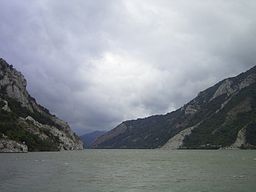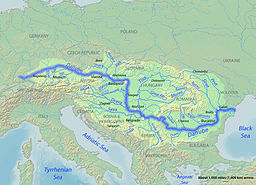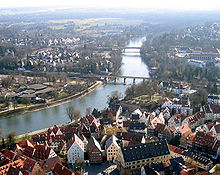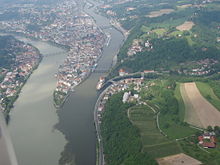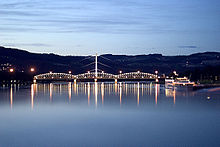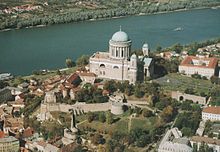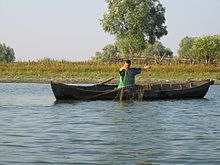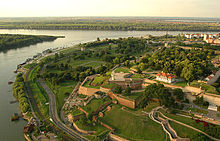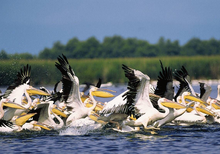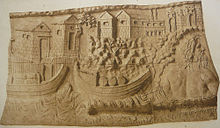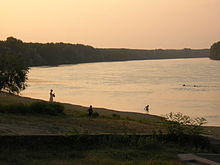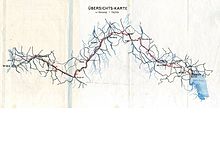
Danube
Background Information
This Schools selection was originally chosen by SOS Children for schools in the developing world without internet access. It is available as a intranet download. Before you decide about sponsoring a child, why not learn about different sponsorship charities first?
| Danube | |
| Donau, Dunaj, Dunărea, Donava, Duna, Dunav, Дунав, Tuna | |
| River | |
|
The Iron Gate, on the Serbian-Romanian border ( Iron Gates natural park and Đerdap national park)
|
|
| Countries | Germany, Austria, Slovakia, Hungary, Croatia, Serbia, Bulgaria, Moldova, Ukraine, Romania |
|---|---|
| Cities | Ulm, Ingolstadt, Regensburg, Linz, Vienna, Bratislava, Győr, Esztergom, Budapest, Vukovar, Novi Sad, Sremski Karlovci, Zemun, Pančevo, Belgrade, Ruse |
| Primary source | Breg |
| - location | Martinskapelle, Black Forest, Germany |
| - elevation | 1,078 m (3,537 ft) |
| - length | 49 km (30 mi) |
| - coordinates | 48°05′44″N 08°09′18″E |
| Secondary source | Brigach |
| - location | St. Georgen, Black Forest, Germany |
| - elevation | 940 m (3,084 ft) |
| - length | 43 km (27 mi) |
| - coordinates | 48°06′24″N 08°16′51″E |
| Source confluence | |
| - location | Donaueschingen |
| - coordinates | 47°57′03″N 08°31′13″E |
| Mouth | Danube Delta |
| - coordinates | 45°13′3″N 29°45′41″E |
| Length | 2,860 km (1,777 mi) |
| Depth | 54 m (177 ft) |
| - Max. depth | 178 m (584 ft) |
| Basin | 817,000 km2 (315,445 sq mi) |
| Discharge | for before delta |
| - average | 6,500 m3/s (229,545 cu ft/s) |
| Discharge elsewhere (average) | |
| - Passau | 580 m3/s (20,483 cu ft/s) 30km before town |
| - Vienna | 1,900 m3/s (67,098 cu ft/s) |
| - Budapest | 2,350 m3/s (82,989 cu ft/s) |
| - Belgrade | 4,000 m3/s (141,259 cu ft/s) |
The Danube (English pronunciation: /ˈdænjuːb/ DAN-yoob) is a river in Central Europe, the continent's second longest after the Volga.
Classified as an international waterway, it originates in the town of Donaueschingen which is in the Black Forest of Germany at the confluence of the rivers Brigach and Breg. The Danube then flows southeast for 2,872 km (1,785 mi), passing through four Central European capitals before emptying into the Black Sea via the Danube Delta in Romania and Ukraine.
Once a long-standing frontier of the Roman Empire, the river passes through or touches the borders of ten countries: Romania (29.0% of basin area), Hungary (11.6%), Serbia (10.2%), Austria (10.0%), Germany (7.0%), Bulgaria (5.9%), Slovakia (5.9%), Croatia (4.4%), Ukraine (3.8%), and Moldova (1.6%). Its drainage basin extends into nine more.
Names and etymology
The Danube was known in Latin as Danubius, Danuvius, Ister, in Ancient Greek as Ἴστρος (Istros). The Dacian/ Thracian name was Τάναις/Donaris/Donaris (upper Danube) and Istros (lower Danube). Its Thraco- Phrygian name was Matoas, "the bringer of luck".
The name Dānuvius is presumably a loan from Celtic ( Gaulish), or possibly Iranic. It is one of a number of river names derived from a Proto-Indo-European language word *dānu, apparently a term for "river", but possibly also of a primeval cosmic river, and of a Vedic river goddess (see Danu), perhaps from a root *dā "to flow/swift, rapid, violent, undisciplined." Other river names with the same etymology include Don, Donets, Dnieper and Dniestr. Dniepr (pre-Slavic Danapir by Gothic historian Jordanes) and Dniestr, from Danapris and Danastius, are presumed from Scythian Iranic *Dānu apara "posterior river" and *Dānu nazdya- "anterior river", respectively.
The Ancient Greek Istros was a borrowing from Thracian/ Dacian meaning "strong, swift", akin to Sanskrit iṣiras "swift".
Since the Norman conquest of England, the English language has used the Latin-derived word Danube.
In the languages of the modern countries through which the river flows, it is:
- Bulgarian: Дунав pronounced: ['dunɐf] (transliterated: Dunav)
- Croatian: Dunav
- German: Donau pronounced [ˈdoːnaʊ̯]
- Hungarian: Duna pronounced [ˈdunɒ]
- Romanian: Dunărea pronounced [ˈdunəre̯a]
- Serbian: Дунав, Dunav, pronounced [dǔnav̞] or [dûnaːv̞]
- Slovak: Dunaj
- Ukrainian: Дунай pronounced [duˈnɑj] (transliterated: Dunai)
- Turkish: Tuna
Geography
Drainage basin
In addition to the bordering countries (see above), the drainage basin includes parts of nine more countries: Bosnia and Herzegovina (4.6%), the Czech Republic (2.9%), Slovenia (2.0%), Montenegro (0.9%), Switzerland (0.2%), Italy (<0.1%), Poland (<0.1%), the Republic of Macedonia (<0.1%) and Albania (<0.1%). The highest point of the drainage basin is the summit of Piz Bernina at the Italy–Switzerland border, 4,049 metres (13,284 ft).
Tributaries
The Danube's watershed extends into many other countries. Many Danubian tributaries are important rivers in their own right, navigable by barges and other shallow-draught boats. From its source to its outlet into the Black Sea, its main tributaries are (in order that they enter):
|
15. Tisza |
Cities


The Danube flows through the following countries and cities (ordered from the source to mouth):
- Germany
- Donaueschingen in the State of Baden-Württemberg – Brigach and Breg rivers join to form the Danube river
- Möhringen an der Donau in Baden-Württemberg
- Tuttlingen in Baden-Württemberg
- Sigmaringen in Baden-Württemberg
- Riedlingen in Baden-Württemberg
- Munderkingen in Baden-Württemberg
- Ehingen in Baden-Württemberg
- Ulm in Baden-Württemberg
- Neu-Ulm in Bavaria
- Günzburg in Bavaria
- Donauwörth in Bavaria
- Neuburg an der Donau in Bavaria
- Ingolstadt in Bavaria
- Kelheim in Bavaria
- Regensburg in Bavaria
- Straubing in Bavaria
- Deggendorf in Bavaria
- Passau in Bavaria
- Austria
- Linz, capital of Upper Austria
- Krems in Lower Austria
- Tulln in Lower Austria
- Vienna – capital of Austria, where the Danube floodplain is called the Lobau, though the Innere Stadt is situated away from the main flow of the Danube (it is bounded by the Donaukanal – 'Danube canal').
- Slovakia
- Bratislava – capital of Slovakia
- Komárno
- Štúrovo
- Hungary
- Croatia
- Vukovar
- Ilok
- Serbia
- Apatin
- Bačka Palanka
- Futog
- Veternik
- Novi Sad
- Sremski Karlovci
- Zemun
- Belgrade – capital of Serbia
- Pančevo
- Smederevo
- Kovin
- Veliko Gradište
- Golubac
- Donji Milanovac
- Kladovo
- Bulgaria
 Danube at Nikopol, Bulgaria in winter
Danube at Nikopol, Bulgaria in winter- Vidin
- Lom
- Kozloduy
- Oryahovo
- Nikopol
- Belene
- Svishtov
- Ruse
- Tutrakan
- Silistra
- Moldova
- Giurgiuleşti
- Ukraine
- Reni
- Izmail
- Kiliya
- Vylkove
- Romania
 The Danube in Sulina, Romania
The Danube in Sulina, Romania- Moldova Nouă
- Orşova
- Drobeta-Turnu Severin
- Calafat
- Bechet
- Dăbuleni
- Corabia
- Turnu Măgurele
- Zimnicea
- Giurgiu
- Olteniţa
- Călăraşi
- Feteşti
- Cernavodă
- Hârşova
- Brăila
- Galaţi – largest port on Danube
- Isaccea
- Tulcea
- Sulina – last city through which it flows
The Danube flows through four capital cities (shown in bold), more than any river in the world.
Islands
- Ada Kaleh
- Balta Ialomiţei
- Belene Island
- Csepel Island
- Donauinsel
- Great Brăila Island
- Great War Island
- Island of Vukovar
- Island of Šarengrad
- Kozloduy Island
- Margaret Island
- Ostrovul Ciocăneşti
- Ostrovul Mare, Islaz
- Ostrvo (Kostolac)
- Ribarsko Ostrvo, Novi Sad
- Vardim Island
- Žitný ostrov
Sectioning
- Upper Section: From spring to Devín Gate. Danube remains a characteristic mountain river until Passau, with average bottom gradient 0.0012% (12 ppm), from Passau to Devín Gate the gradient lessens to 0.0006% (6 ppm).
- Middle Section: From Devín Gate to Iron Gate. The riverbed widens and the average bottom gradient becomes only 0.00006% (0.6 ppm).
- Lower Section: From Iron Gate to Sulina, with average gradient as little as 0.00003% (0.3 ppm).

The Danube is navigable by ocean ships from the Black Sea to Brăila in Romania and by river ships to Kelheim, Bavaria, Germany; smaller craft can navigate further upstream to Ulm, Württemberg, Germany. About 60 of its tributaries are also navigable.
Since the completion of the German Rhine–Main–Danube Canal in 1992, the river has been part of a trans-European waterway from Rotterdam on the North Sea to Sulina on the Black Sea (3500 km). In 1994 the Danube was declared one of ten Pan-European transport corridors, routes in Central and Eastern Europe that required major investment over the following ten to fifteen years. The amount of goods transported on the Danube increased to about 100 million tons in 1987. In 1999, transport on the river was made difficult by the NATO bombing of three bridges in Serbia during the Kosovo War. Clearance of the resulting debris was completed in 2002, and a temporary pontoon bridge that hampered navigation was removed in 2005.
At the Iron Gate, the Danube flows through a gorge that forms part of the boundary between Serbia and Romania; it contains the Iron Gate I Hydroelectric Power Station dam, followed at about 60 km downstream (outside the gorge) by the Iron Gate II Hydroelectric Power Station. On 13 April 2006, a record peak discharge at Iron Gate Dam reached 15,400 m³/s.
There are three artificial waterways built on the Danube: the Danube–Tisa–Danube Canal (DTD) in the Banat and Bačka regions ( Vojvodina, northern province of Serbia); the 64 km Danube–Black Sea Canal, between Cernavodă and Constanţa (Romania) finished in 1984, shortens the distance to the Black Sea by 400 km; the Rhine-Main-Danube Canal (about 171 km), finished in 1992, linking the North Sea to the Black Sea.
Piracy
In 2010-2012, shipping companies (especially from Ukraine) claimed that their vessels suffered from "regular pirate attacks", on the Serbian and Romanian stretches of the Danube (i.e. inside the European Union's territory). However, these transgressions may not be considered acts of piracy, as defined according to the United Nations Convention on the Law of the Sea, but rather instances of "river robbery".
On the other hand, media reports say the crews on transport ships often steal and sell their own cargo and then blame the plundering on “pirates”, and the alleged attacks are not piracy but small-time contraband that is taking place along the river.
Danube delta
The Danube Delta has been a UNESCO World Heritage Site since 1991. Its wetlands (on the Ramsar list of wetlands of international importance) support vast flocks of migratory birds, including the endangered Pygmy Cormorant (Phalacrocorax pygmaeus). Rival canalization and drainage schemes threaten the delta: see Bastroe Channel. The Danube Delta (Romanian: Delta Dunării pronounced [ˈdelta ˈdunərij]; Ukrainian: Дельта Дунаю, Del'ta Dunaju) is the second largest river delta in Europe, after the Volga Delta, and is the best preserved on the continent. The greater part of the Danube Delta lies in Romania (Tulcea county), while its northern part, on the left bank of the Chilia arm, is situated in Ukraine (Odessa Oblast). The approximate surface is 4152 km², of which 3446 km² are in Romania. If one includes the lagoons of Razim-Sinoe (1015 km² of which 865 km² water surface), which are located south of the delta proper, but are related to it geologically and ecologically (their combined territory is part of the World Heritage Site), the total area of the Danube Delta reaches 5165 km². The waters of the Danube, which flow into the Black Sea, form the largest and best preserved of Europe's deltas. The Danube delta hosts over 300 species of birds as well as 45 freshwater fish species in its numerous lakes and marshes.
International cooperation
Ecology and environment
The International Commission for the Protection of the Danube River (ICPDR) is an organization consisting of 14 member states (Germany, Austria, the Czech Republic, Slovakia, Slovenia, Hungary, Croatia, Bosnia and Herzegovina, Serbia, Bulgaria, Romania, Moldova, Montenegro and Ukraine) and the European Union. The commission, established in 1998, deals with the whole Danube River Basin, which includes tributaries and the groundwater resources. Its goal is to implement the Danube River Protection Convention by promoting and coordinating sustainable and equitable water management, including conservation, improvement and rational use of waters and the implementation of the EU Water Framework Directive.
The Danube Commission is concerned with the maintenance and improvement of the river's navigation conditions. It was established in 1948 by seven countries bordering the river. Members include representatives from Austria, Bulgaria, Croatia, Germany, Hungary, Moldova, Slovakia, Romania, Russia, Ukraine, and Serbia, It meets regularly twice a year. It also convenes groups of experts to consider items provided for in the commission's working plans.
The commission dates to the Paris Conferences of 1856 and 1921, which established for the first time an international regime to safeguard free navigation on the Danube.
Geology
Although the headwaters of the Danube are relatively small today, geologically, the Danube is much older than the Rhine, with which its catchment area competes in today's southern Germany. This has a few interesting geological complications. Since the Rhine is the only river rising in the Alps mountains which flows north towards the North Sea, an invisible line beginning at Piz Lunghin divides large parts of southern Germany, which is sometimes referred to as the European Watershed.
Before the last ice age in the Pleistocene, the Rhine started at the southwestern tip of the Black Forest, while the waters from the Alps that today feed the Rhine were carried east by the so-called Urdonau (original Danube). Parts of this ancient river's bed, which was much larger than today's Danube, can still be seen in (now waterless) canyons in today's landscape of the Swabian Alb. After the Upper Rhine valley had been eroded, most waters from the Alps changed their direction and began feeding the Rhine. Today's upper Danube is but a meek reflection of the ancient one.
Since the Swabian Alb is largely shaped of porous limestone, and since the Rhine's level is much lower than the Danube's, today subsurface rivers carry much water from the Danube to the Rhine. On many days in the summer, when the Danube carries little water, it completely oozes away noisily into these underground channels at two locations in the Swabian Alp, which are referred to as the Donauversickerung ( Danube Sink). Most of this water resurfaces only 12 km south at the Aachtopf, Germany's wellspring with the highest flow, an average of 8500 liters per second, north of Lake Constance—thus feeding the Rhine. The European Water Divide applies only for those waters that pass beyond this point, and only during the days of the year when the Danube carries enough water to survive the sink holes in the Donauversickerung.
Since such large volumes of underground water erode much of the surrounding limestone, it is estimated that the Danube upper course will one day disappear entirely in favour of the Rhine, an event called stream capturing
The hydrological parameters of Danube are regularly monitored in Croatia at Batina, Dalj, Vukovar and Ilok.
History
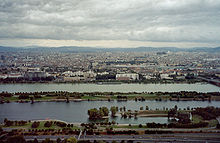
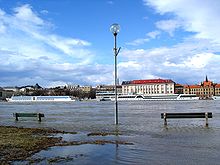
The Danube basin was the site of some of the earliest human cultures. The Danubian Neolithic cultures include the Linear Pottery cultures of the mid-Danube basin. Many sites of the sixth-to-third millennium BC Vinča culture, (Vinča, Serbia) are sited along the Danube. The third millennium BC Vučedol culture (from the Vučedol site near Vukovar, Croatia) is famous for its ceramics.
Alexander the Great defeated the Triballian king Syrmus and the northern barbarian Thracian and Illyrian tribes by advancing from Macedonia as far as the Danube in 336 BC.
The river was part of the Roman Empire's Limes Germanicus. The Romans often used the river Danube as a northern border for their empire.
Ancient cultural perspectives of the lower Danube
Part of the Danubius or Istros river was also known as (together with the Black Sea) the Okeanos in ancient times, being called the Okeanos Potamos (Okeanos River). The lower Danube was also called the Keras Okeanoio (Gulf or Horn of Okeanos) in the Argonautica by Apollonius Rhodos (Argon. IV. 282). The lower Danube has a slow, deep, wide course, so it can be seen why it was considered as part of the Okeanos.
At the end of the Okeanos Potamos, is the holy island of Alba (Leuke, Pytho Nisi, Isle of Snakes), sacred to the Pelasgian (and later, Greek) Apollo, greeting the sun rising in the east. Hecateus Abderitas refers to Apollo's island from the region of the Hyperboreans, in the Okeanos. It was on Leuke, in one version of his legend, that the hero Achilles was buried (to this day, one of the mouths of the Danube is called Chilia). Old Romanian folk songs recount a white monastery on a white island with nine priests.
Ottoman–Hungarian and Ottoman–Habsburg rivalry along the Danube
Between the late 14th and late 19th centuries, the Ottoman Empire competed first with the Kingdom of Hungary and later with the Austrian Habsburgs for controlling the Danube, which formed the northern border of the Ottoman Empire for centuries. Many of the Ottoman–Hungarian Wars (1366–1526) and Ottoman–Habsburg wars (1526–1791) were fought along the river.
The most important wars of the Ottoman Empire along the Danube include the Battle of Nicopolis (1396), the Battle of Mohács (1526), the first Turkish Siege of Vienna (1529), the Siege of Esztergom (1543), the Long War (1591–1606), the Battle of Vienna (1683) and the Great Turkish War (1683–1699).
The last major war of the Ottoman Empire along the Danube was the Russo-Turkish War (1877–1878).
Economics
Drinking water
Along its course, the Danube is a source of drinking water for about twenty million people. In Baden-Württemberg, Germany, almost thirty percent (as of 2004) of the water for the area between Stuttgart, Bad Mergentheim, Aalen and Alb-Donau (district) comes from purified water of the Danube. Other cities such as Ulm and Passau also use some water from the Danube.
In Austria and Hungary, most water is drawn from ground and spring sources, and only in rare cases is water from the Danube used. Most states also find it too difficult to clean the water because of extensive pollution; only parts of Romania where the water is cleaner still obtain drinking water from the Danube on a regular basis.
As "Corridor VII" of the European Union, the Danube is an important transport route. Since the opening of the Rhine–Main–Danube Canal, the river connects the Port of Rotterdam and the industrial centres of Western Europe with the Black Sea and, also, through the Danube – Black Sea Canal, with the Port of Constanţa.
The waterway is designed for large-scale inland vessels (110×11.45 m) but it can carry much larger vessels on most of its course. The Danube has been partly canalized in Germany (5 locks) and Austria (10 locks). Proposals to build a number of new locks to improve navigation have not progressed, due in part to environmental concerns.
Downstream from the Freudenau locks in Vienna, canalization of the Danube was limited to the Gabčíkovo dam and locks near Bratislava and the two double Iron Gate locks in the border stretch of the Danube between Serbia and Romania. These locks have larger dimensions (similar to the locks in the Russian Volga river, some 300 by over 30 m). Downstream of the Iron Gate, the river is free flowing all the way to the Black Sea, a distance of more than 860 kilometres.
The Danube connects with the Rhine–Main–Danube Canal at Kelheim, with the Donaukanal in Vienna, and with the Danube–Black Sea Canal at Cernavodă.
Apart from a couple of secondary navigable branches, the only major navigable rivers linked to the Danube are the Drava, Sava and Tisa. In Serbia, a canal network also connects to the river; the network, known as the Danube–Tisa–Danube Canals, links sections downstream.
Fishing
The importance of fishing on the Danube, which was critical in the Middle Ages, has declined dramatically. Some fishermen are still active at certain points on the river, and the Danube Delta still has an important industry.
The Upper Danube ecoregion alone has about 60 fish species and the Lower Danube– Dniester ecoregion has about twice as many. Among these are an exceptionally high diversity of sturgeon, a total of six species ( beluga, Russian sturgeon, bastard sturgeon, sterlet, starry sturgeon and European sea sturgeon), but these are all threatened and have largely–or entirely in the case of the European sea sturgeon–disppeared from the river. The huchen, one of the largest species of salmon, is endemic to the Danube basin, but has been introduced elsewhere by humans.
Tourism
Important tourist and natural spots along the Danube include the Wachau Valley, the Nationalpark Donau-Auen in Austria, Gemenc in Hungary, the Naturpark Obere Donau in Germany, Kopački rit in Croatia, Iron Gate in Serbia and Romania, the Danube Delta in Romania, and the Srebarna Nature Reserve in Bulgaria.
The Danube Banks in Budapest are a part of Unesco World Heritage sites, they can be viewed from a number of sightseeing cruises offered in the city.
The Danube Bend is also a popular tourist destination.
The Danube Bike Trail (also called Danube Cycle Path or the Donauradweg) is a bicycle trail along the river. It is divided into four sections:
- Donaueschingen- Passau (559 km)
- Passau-Vienna (340 km)
- Vienna-Budapest (306 km)
- Budapest-Black Sea (1670 km)
Important national parks
- Naturpark Obere Donau (Germany)
- Donauauen zwischen Neuburg und Ingolstadt (Germany) - map
- Nature protection area Donauleiten (Germany)
- Nationalpark Donau Auen (Austria) - map
- Chránená krajinná oblasť Dunajské luhy (Slovakia) - map
- Duna-Ipoly Nemzeti Park (Hungary) - map
- Gemenc (Hungary) - map
- Naturalpark Kopački Rit (Croatia) - map
- Gornje Podunavlje Nature Reserve (Serbia) - map
- Fruška Gora National park (Serbia)
- Koviljsko-petrovaradinski rit Nature Reserve (Serbia)
- Great War Island Nature Reserve (Serbia)
- Đerdap National park (Serbia)
- Iron Gates Natural Park (Romania)
- Persina Nature Park (Bulgaria) - map
- Kalimok-Brushlen Protected Site (Bulgaria) - map
- Srebarna Nature Reserve (Bulgaria) - map
- Natural Park Măcin Mountains (Romania)
- Natural Park Small Island of Brăila (Romania)
- Biosphere Reserve Danube Delta (Romania) - map
Cultural significance
- The Danube is mentioned in the title of a famous waltz by Austrian composer Johann Strauss, An der schönen, blauen Donau (On the Beautiful Blue Danube). This piece is well known across the world and is also used widely as a lullaby. The Waves of the Danube ( Romanian: Valurile Dunării) is a waltz by the Romanian composer Ion Ivanovici (1845–1902). Joe Zawinul wrote a symphony about the Danube called Stories of the Danube. It was performed for the first time at the 1993 Bruckner festival, at Linz.
- The Danube figures prominently in the Bulgarian National Anthem, as a symbolic representation of the country's natural beauty. In Lithuanian folklore songs appearance of Danube (Dunojus, Dunojėlis) is more common than the appearance of the longest Lithuanian river Neman.
- The German tradition of landscape painting, the Danube school, was developed in the Danube valley in the 16th century One of Claudio Magris's masterpiece is called Danube ( ISBN 1-86046-823-3).
- Jules Verne's The Danube Pilot (1908) ("Le Pilote du Danube") depicts the adventures of fisherman Serge Ladko as he travels down the river. Algernon Blackwood's The Willows, about a boat excursion on the river, is considered one of the greatest stories in the literature of the supernatural.
- The river is the subject of the film The Ister (2004) (official site here ). Parts of the German road movie Im Juli take place along the Danube. In Nicolas Roeg's 1980 film Bad Timing, the border crossing over the Danube between Bratislava and Vienna is a recurring site in which the romance between Milena (Teresa Russell), Alex (Art Garfunkel) and Milena's husband Stefan (Denholm Elliot) is played out.
- In the Star Trek universe, the Danube-class runabout is a type of starship used by the Federation Starfleet, most notably in the Deep Space Nine series.
- The river is mentioned a great number of times throughout the Earth's Children Saga by Jean M. Auel, especially in the book The Plains of Passage, when the main characters Ayla and Jondalar travel west along this river, which they call the Great Mother River, due to its big size.
- Miklós Jancsó's film the Blue Danube Waltz (1992)
- The Hungarian sweet speciality, Duna kavics ("Danube Pebbles") is named after the river.
- A Hungarian folk ensemble, the Danube Folk Ensemble (Duna Művészegyüttes) is named after the river. The group is made up of 30 dancers and musicians. During their performances they show the Hungarian folk music, dance and costumes.
- There are Hasidic (Chabad Nigunnim) songs called "dunai", dating from around 1800. They are often lullabys and are named after the Dunay river. Farmers around the river used to come to it and sing spiritual songs to thank their god for the great beauty which they saw every day.

